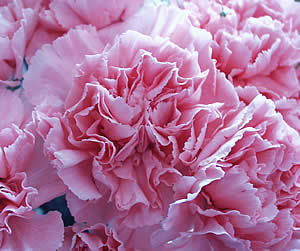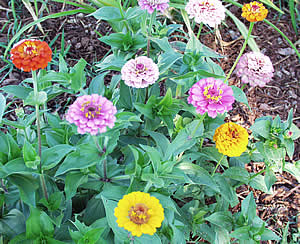Sweet Peas
 The
The
enchanting Sweet Pea ? what does it bring to mind? The song lyrics,
?Oh, Sweet Pea, c?mon and dance with me . . .?, perhaps
the darling baby Sweet Pea with Popeye and Olive Oyl, or even a term
of endearment in your own home. What could inspire this token of affection?
The lovely ?Queen of the Annuals?, Lathyrus odoratus, the
flowering Sweet Pea. Gorgeous colors, soft textures, prolific blooms,
and oh-so-glorious scent have made Sweet Peas a favorite among gardeners
worldwide.
Who, When and Where
The origins
of the Sweet Pea are said to be in Sicily and Southern Italy as a wildflower.
Around 1695, Franciscus Cupani, a Sicilian monk, took interest in the
small purple and blue flowers that grew in the monastery garden in Palermo.
He gathered seeds and sent them to acquaintances in England and Amsterdam.
From there the popularity of the Sweet Pea spread, encouraging the development
of new varieties, reaching 264 varieties by 1900. In that year the National
Sweet Pea Society was founded in the United Kingdom and at present continues
to broaden the public knowledge of Sweet Peas (visit www.sweetpeas.org.uk for more information.)
 Growing
Growing
Sweet Peas
Location, soil,
and timing – three essentials for growing most any plant. Sweet Peas
like morning sun and afternoon shade. To prepare the soil, dig deep
(about 12 inches) and enrich the soil with compost or manure. For temperate
climates, plant Sweet Peas in late Fall to give them a head-start in
growth for blooming in early Spring. In colder climates, plant as soon
as the soil can be worked or start seeds indoors.
For faster seed germination, soak seeds overnight in water or nick the
seed coat opposite the growing point. When the plants are 4-5 inches
high, pinch off the tips to cause branching of stems, resulting in a
stronger plant. As the Sweet Peas grow, they will need a trellis or
pole support. Depending on the variety, they can reach 6 feet (or taller!) Sweet Peas like regular moisture and shade
for their “feet”, or mulch  around
around
the bases of the plants.
As Sweet Peas bloom, be sure to pick them! The more you snip, the more
they’ll bloom. If you don’t, the plant will begin to go to seed and
you won’t see or smell very many flowers. Watch out for seed pods –
cut them off, unless you are at the end of the growing season and want
to save seeds for the next year. It is also beneficial to cut off some
of the foliage when you cut flowers as this will encourage more branching,
more growth, and more lovely blooms.




